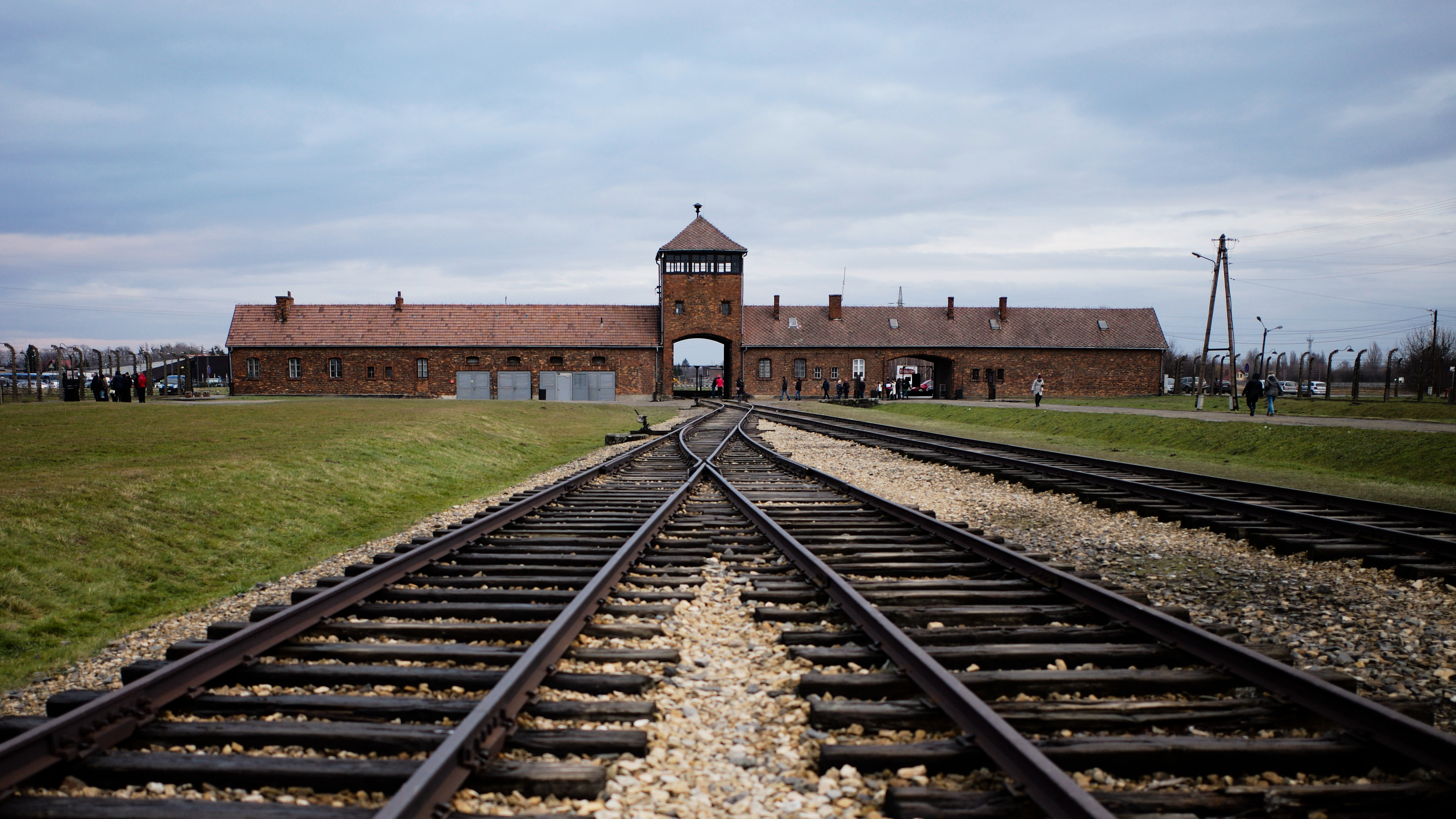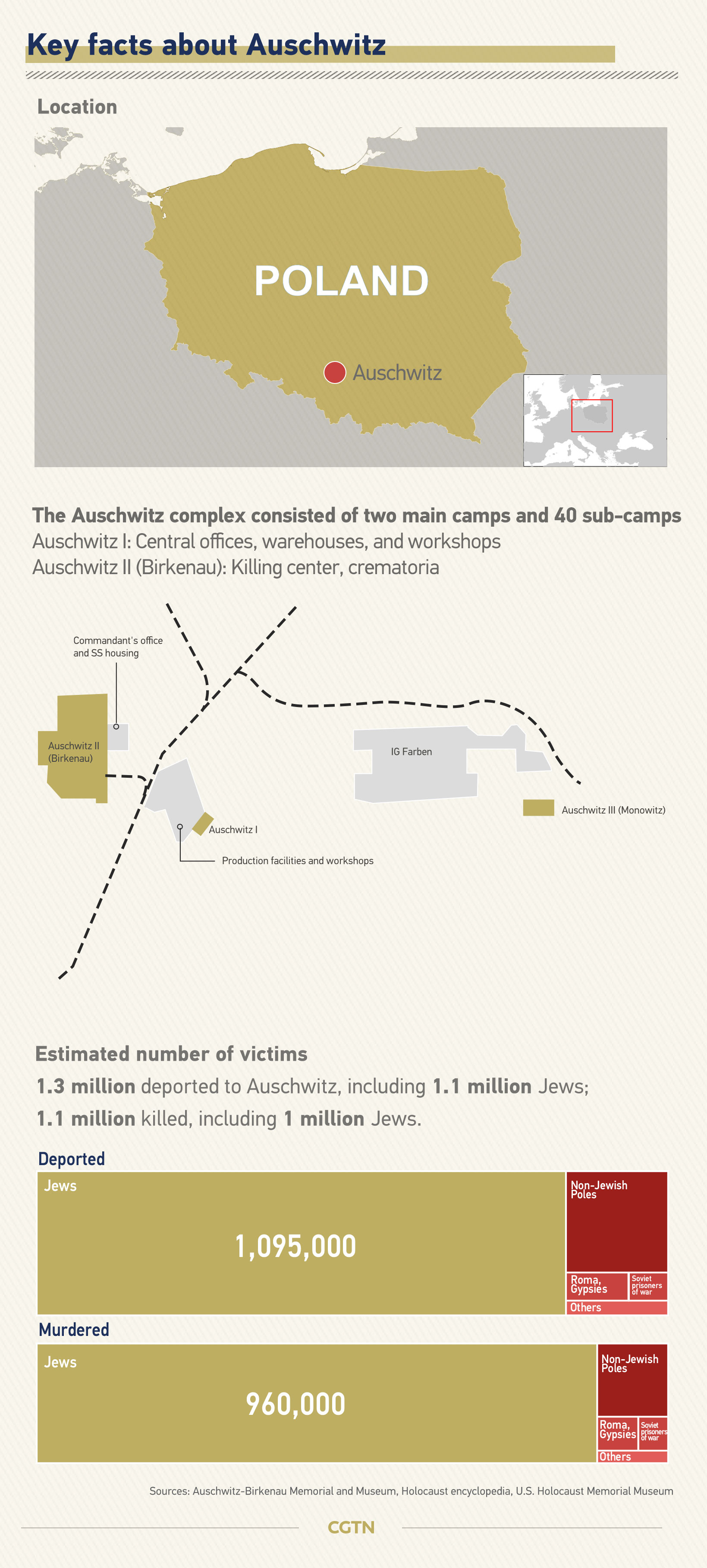
The gatehouse and the railway tracks that led hundreds of thousands to their deaths at the former Nazi death camp of Auschwitz-Birkenau in Oswiecim, Poland, December 7, 2019. /AP Photo
The gatehouse and the railway tracks that led hundreds of thousands to their deaths at the former Nazi death camp of Auschwitz-Birkenau in Oswiecim, Poland, December 7, 2019. /AP Photo
It wasn't the first death camp set up by the Nazis but it remains the most famous, the image of the dark gatehouse and the rail tracks that led over one million people to their deaths seared on the minds of millions worldwide.
Auschwitz has become synonymous with Nazi terror, the massacre of six million Jews, and the ruthless machinery that tried to wipe out ethnic and religious minorities, political opponents, homosexuals, "asocials" and the disabled.
International Holocaust Remembrance Day is now held every year on the day the camp was liberated by the Soviet Red Army soldiers on January 27, 1945.
On Monday, survivors as well as heads of state and top representatives from around the world will take part in a 75th anniversary ceremony at the site of the former camp in southern Poland.
A killing machine
In all, 1.1 million people are believed to have died at Auschwitz, making it the deadliest of the 1,000 extermination and concentration camps the Nazis set up around Europe during their brutal regime.
About one million were Jews, most of them gassed on arrival. But there were also 70,000-75,000 Poles, 20,000 Roma or gypsies, 15,000 Soviet prisoners of war (POWs) and 10,000-15,000 others. Deportees came from Hungary, France, the Netherlands, Greece, Austria or Norway.
This was part of the Nazis' "Final Solution": the attempted extermination of all Jews. Alongside Auschwitz, other camps such as Sobibor, Treblinka, Bergen-Belsen and Dachau have gone down in history as sites of mass murder.

Auschwitz actually consisted of two main camps and about 40 sub-camps. Set up in 1940 near Oswiecim, a Polish town some 50 kilometers from today's border with Slovakia and the Czech Republic, it began as a concentration camp but soon became a testing ground for the Nazis' worst atrocities.
The words "Arbeit macht frei" (Work sets you free) above the main gate belied the truth: most of the 1.3 million deportees who arrived in the cattle wagons, shipped in from every corner of the continent, never had the chance to lift a tool. Instead, they were sent straight to the gas chambers, their bodies then reduced to ash in one of the camp's giant crematoria.
Others died of backbreaking work, hunger or disease, were submitted to medical experiments – including by the infamous Dr. Josef Mengele – tortured or executed.
Even liberation came with a bitter note as Nazi commanders tried to cover up their crimes, while the Red Army approached in January 1945, by sending inmates on "death marches" to other camps or executing those too weak to follow.
A need to remember
On Monday, the Auschwitz-Birkenau Memorial and Museum will host an international ceremony with some 200 former prisoners and Holocaust survivors from as far as the U.S., Australia and Canada due to attend, alongside Polish President Andrzej Duda, German President Frank-Walter Steinmeier and Israeli President Reuven Rivlin, as well as over 50 representatives from other countries, the European Union and the United Nations.
The United Nations in New York will also hold a memorial ceremony.

Ahead of the anniversary, leaders and dignitaries from 40 countries – including Rivlin, Steinmeier, French President Emmanuel Macron and Russian President Vladimir Putin – gathered at Israel's Yad Vashem memorial on Thursday for the fifth World Holocaust Forum.
Read more: World Holocaust Forum: 'Never again'
In a high-profile move, the secretary-general of the Muslim World League, Sheikh Mohammad Alissa, also visited Auschwitz with David Harris, the director of the American Jewish Committee (AJC) – the most senior Muslim leader ever to set foot in the former death camp.
History repeating itself?
The 75th anniversary comes amid fears of rising anti-Semitism, reflected in the theme for this year's Auschwitz ceremony, a quote by a Polish Jew killed at the camp in 1944: "We have a dark premonition because we know."
Last October, two people were killed in an attack on a synagogue in Halle, Germany. New York experienced a series of anti-Semitic attacks in December, and in 2018, a mass shooting at a synagogue in Pittsburgh, U.S., left 11 dead.
In France, Germany, Slovakia and the UK, Jewish cemeteries have been vandalized, and swastikas and anti-Semitic graffiti have been spray-painted on walls and shop windows. In a survey published last week, 70 percent of French Jews said they had been verbally or physically attacked, and 37 percent said they now avoided wearing religious symbols or attire.

Vandalized tombs with tagged swastikas are pictured in the Jewish cemetery of Quatzenheim, France, February 19, 2019. /AP Photo
Vandalized tombs with tagged swastikas are pictured in the Jewish cemetery of Quatzenheim, France, February 19, 2019. /AP Photo
A rise in popularity for far-right parties and groups, such as the far-right Alternative for Germany (AfD), which has been accused of fueling anti-Semitism, has contributed to this atmosphere of fear. At a 2017 rally in Charlottesville, U.S., white supremacists carried torches and swastika flags and chanted "Jews will not replace us" in scenes reminiscent of 1930s Nazi rallies.
"I wish I could say that we Germans have learned from history once and for all. But I cannot say that when hatred is spreading," Steinmeier said Thursday at Yad Vashem. "Our age is a different age, the words are not the same, the perpetrators are not the same, but it is the same evil and there remains only one answer: Never again."
The call to remember is all the more urgent as the generation that experienced the Holocaust is quickly dying out. This year will likely be the last major anniversary for many survivors, who are now in their 80s and 90s.
(Graphics: Zhao Hong)